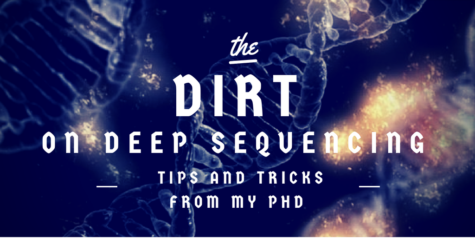The Dirt on Deep Sequencing- My Experience with the Revolutionary Technique
Temperatures hit a record high this weekend in Chicago. With the mercury rising in my apartment, fans monopolized every outlet and my windows gaped open at all hours. Travelers and tourists in the Loop dabbed at beads of sweat hanging on their foreheads, their cheeks flushed and bare shoulders browning in the sun. On the other side of the Windy City, imagine opening the door to Loyola’s Center for Translational Research and Education and being greeted by a rush of A/C from our LEED-certified building. It chills you to your core. That’s what introducing deep sequencing into my dissertation project felt like. Absolutely refreshing.
I’ve been using deep sequencing, also known as next-generation sequencing or second-generation sequencing, to make sense of the biologically complex changes occurring in cardioprotection. Deep sequencing is a technique that allows scientists to determine the quantity and identity of nucleotide sequences in a biological sample. I hypothesized that there were measurable changes in the left ventricular transcriptome following electrically-induced cardioprotection. RNA-sequencing was applied to quantify the relative abundance and differential expression of genes after the stimulus. There is ample literature offering a detailed overview of the methods and workflow, which I referenced frequently throughout the project.1,2 I also received a lot of help from the very skilled bioinformatics experts at Loyola Genomics Core and their collaborators, who completed the sequencing and analysis. Herein, I’m offering an honest reflection on my first experience with RNA-sequencing. It’s been exciting and satisfying to work through these challenges:
- Challenge #1: Starting out strong. Because of the sensitivity of the technique, any confounding variables in the sample collection and RNA isolation steps must be meticulously controlled for.
- Solution: The subjects were sex- and age-matched, treatments were administered on the same day and time, and tissues were collected identically. The RNA was of high quality and abundance before it could be processed (this took a couple of tries). A dedicated RNA work station was used to shield my samples from RNAses, and we limited freezing and thawing whenever possible.
- Challenge #2: Making sense of results afterwards. Large data sets need to be properly analyzed and interpreted before substantial conclusions can be drawn.
- Solution: There are a number of sophisticated computation tools that we used with our Core to analyze the genes and pathways that changed between conditions. I chose to focus on genes that had high base read counts, high fold changes between the sham and treatment, and a known role in cardioprotection. I validated fold changes with RT-qPCR before utilizing pharmacological inhibitors or knock-out mouse models to determine the functional role of those genes as mediators of cardioprotection.
- Challenge #3: Time and money throughout. Sequencing N=3-4 in 2 groups had a 4-8 week turnaround and cost us several thousand dollars to complete.
- Solution: Well, there isn’t an easy one here. I can, however, advocate for patience with the process and confidence in the product. It appears that as technologies continue advancing and more investigators are using this technique, speed is increasing and prices are dropping globally.
RNA-sequencing has revolutionized my dissertation project. I began with a small number of RNA samples and ended with a list of potential gene candidates and a burning curiosity about their functions. The findings are driving my current research pursuits and helping me to answer our biggest questions about the molecular mechanisms of electrically-induced cardioprotection.

References:
- Goldman, D., & Domschke, K. (2014). Making sense of deep sequencing. The International Journal of Neuropsychopharmacology, 17(10), 1717–1725. http://doi.org/10.1017/S1461145714000789
- Han, Y., Gao, S., Muegge, K., Zhang, W., & Zhou, B. (2015). Advanced Applications of RNA Sequencing and Challenges. Bioinformatics and Biology Insights, 9(Suppl 1), 29–46. http://doi.org/10.4137/BBI.S28991

Annie Roessler is a PhD Candidate at Loyola University in Chicago, IL. Her research focuses on the neurobiology and molecular mechanisms of electrically-induced cardioprotection. She tweets @ThePilotStudy and blogs at flaskhalffull.com